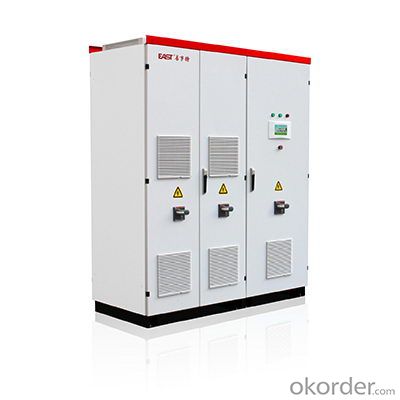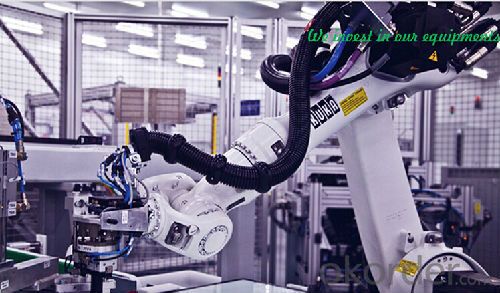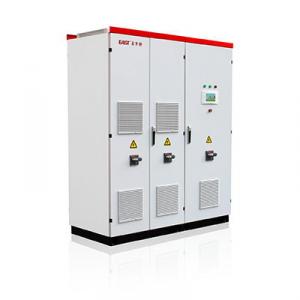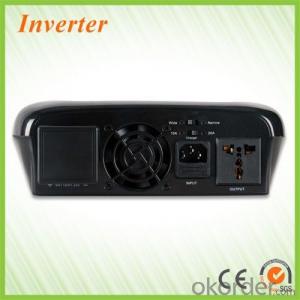EA500KTL/H Wider Input Voltage Range and Higher Efficiency ON-GRID PV - Central Inverter
- Loading Port:
- China main port
- Payment Terms:
- TT or LC
- Min Order Qty:
- 1 pc
- Supply Capability:
- 1000 pc/month
OKorder Service Pledge
OKorder Financial Service
You Might Also Like
EA500KTL/H
EA500KTF is designed with external isolation transformer. It has wider input voltage range and higher efficiency. Moreover, optical fiber isolation technology has been adopted to increase its anti-interference ability. Complete protection, higher MPPT efficiency, simple monitoring and capability of parallel operation make it ideal for large scale PV power plant.
● Maximum efficiency up to 98.7% (without transformer)
● Effective IGBT module
● Wide MPPT range, convenient for module configuration
● With DSP + CPLD digital control technology, having complete protection, safe and reliable
● Advanced MPPT (Maximum Power Point Tracking) algorithms
● Advanced Anti-islanding technology
● Efficient thermal system design, suitable for critical PV applications
● Multilingual LCD, easy to operate
● Integrated multi-communication interfaces, easy to monitor
● Low voltage ride through function
● For large centralized power plant connecting to high-voltage grid (with external step-up transformer)
● Active and reactive power regulation function (optional)
● TÜV CE, CQC certification
Specification / Type | EA500KTL | EA500KTH |
Input (DC) | ||
Max DC Voltage | 1000Vdc | |
Full-load MPPT Voltage Range | 450~820Vdc | |
Max DC Power | 550KWp | |
Max DC Current | 1200A | 1100A |
Number of DC Inputs | 16 | 16 |
Output (AC) | ||
Nominal AC Power | 500KW | |
Nominal AC Voltage | 270Vac | 350Vac |
AC Voltage Range | 210~310Vac | 245~362Vac |
Nominal Frequency | 50Hz/60Hz | |
Frequency Tolerance Range | 47-51.5Hz/57-61.5Hz | |
Distortion (THD%) | <3%(at nominal power) | |
Power Factor (Cos phi) | 0.9(leading)~0.9(lagging) | |
System Parameters | ||
Max Efficiency | 98.7% | |
Euro Efficiency | 98.5% | |
Protection Degree | IP20 (indoor) | |
Night Consumption | <100W | |
Operation Temperature Range | -25℃~+55℃ | |
Cooling | forced-air cooling | |
Relative Humidity | 0-95%, no condensation | |
Max Working Altitude | 2000m (derating above 3000m) | |
Display and Communication | ||
Display | LCD | |
Standard Communication | RS485 | |
Optional Communication | Ethernet /USB | |
Structure Parameters | ||
Dimensions(W×D×H) | 1800×800×2200mm | 1800×800×2200mm |
Weight | 1500kg | 1500kg |
· Q. What is an UPS and What it is for ?
An uninterruptible power supply (UPS) is a device that allows your computer or telephone switch or critical equipement to keep running for at least a short time or longer time when the primary power source is lost. It also provides protection from power surges, spikes, brownouts, interference and other unwanted problems on the supported equipment.
· Q. How long the UPS to run when power goes?
This can take 3 paths.
1.You can pick a UPS that is rated for pretty much the full VA you need so it will be running at 100% of capability and will thus last 'n' minutes.
2.You can pick a UPS that is rated at a much higher VA value than you really need so, for example, is running at 50% of capability and will thus last for longer than the UPS from option 1.
3.You can use extra external battery packs to run for longer. If charging capability allows, the more and the bigger batteries you take with, the longer time UPS runs.
or using a generator after about 6 hours, it will be more cost-effective, with a short runtime UPS to bridge the generator start-up gap.



- Q:How long do solar inverters typically last?
- Solar inverters typically have a lifespan of 10 to 15 years, but this can vary depending on factors such as quality, maintenance, and usage.
- Q:What are the signs of a faulty solar inverter?
- Some signs of a faulty solar inverter include a complete lack of power generation, inconsistent or fluctuating power output, error messages or fault codes displayed on the inverter, unusual or excessive noise coming from the inverter, and visual indicators such as flickering lights or abnormal behavior of connected devices.
- Q:Is the PV inverter a current source or a voltage source?
- The inverter is mainly composed of a switching element such as a transistor, and turns the DC input into an AC output by repeatedly turning ON-OFF the switching element in a regular manner.
- Q:Can a solar inverter be used in systems with different module types?
- Yes, a solar inverter can be used in systems with different module types. Solar inverters are designed to convert the DC power generated by solar panels into usable AC power for homes or businesses. They typically have a wide input voltage range and are compatible with various module types, including monocrystalline, polycrystalline, and thin-film panels. However, it is essential to ensure that the inverter's specifications are compatible with the specific module types being used to optimize efficiency and performance.
- Q:What is the importance of voltage and frequency control in a solar inverter?
- Voltage and frequency control are crucial in a solar inverter as they ensure the stability and reliability of the electrical system. Voltage control regulates the output voltage of the inverter, ensuring it is within safe limits and compatible with the grid or the connected appliances. This is important to protect the electrical devices from overvoltage or undervoltage conditions, which could potentially damage them. Frequency control, on the other hand, maintains the output frequency of the inverter in synchronization with the grid frequency. This synchronization is vital for the seamless integration of the solar power into the existing electrical grid. Inconsistent frequencies can lead to instability, power quality issues, and potential damage to equipment. Overall, voltage and frequency control in a solar inverter play a significant role in maintaining a reliable and efficient electrical system, safeguarding the connected appliances, and ensuring the proper integration of solar power into the grid.
- Q:What is the difference between a PV inverter and a solar inverter?
- The main function of photovoltaic grid-connected inverter is to convert the DC power of the solar PV module into the same frequency as the sinusoidal AC power of the grid (the grid is generally AC power grid, DC can not be directly connected)
- Q:How does a solar inverter handle grid frequency deviations?
- A solar inverter handles grid frequency deviations by constantly monitoring the grid frequency. When the grid frequency deviates from the standard range, the inverter adjusts its output frequency accordingly to match the grid frequency. This allows the inverter to maintain synchronization with the grid and continue injecting power efficiently, ensuring stability and reliability of the solar power system.
- Q:How does a solar inverter handle voltage regulation during sudden load changes?
- A solar inverter handles voltage regulation during sudden load changes by continuously monitoring the voltage and current outputs from the solar panels. When there is a sudden increase or decrease in the load, the inverter adjusts its power output accordingly to maintain a stable and consistent voltage level. This is achieved through a combination of control algorithms and power electronics within the inverter, ensuring that the voltage remains within an acceptable range to meet the demands of the load.
- Q:Can a solar inverter be used for both single-phase and three-phase applications?
- No, a solar inverter cannot be used for both single-phase and three-phase applications. Different types of inverters are designed specifically for either single-phase or three-phase systems, as they have different voltage and power requirements.
- Q:Can a solar inverter convert DC power to AC power during a power outage?
- No, a solar inverter cannot convert DC power to AC power during a power outage. During a power outage, the solar inverter relies on the grid to function, and without grid power, it cannot convert DC power from the solar panels into usable AC power.
1. Manufacturer Overview |
|
|---|---|
| Location | |
| Year Established | |
| Annual Output Value | |
| Main Markets | |
| Company Certifications | |
2. Manufacturer Certificates |
|
|---|---|
| a) Certification Name | |
| Range | |
| Reference | |
| Validity Period | |
3. Manufacturer Capability |
|
|---|---|
| a)Trade Capacity | |
| Nearest Port | |
| Export Percentage | |
| No.of Employees in Trade Department | |
| Language Spoken: | |
| b)Factory Information | |
| Factory Size: | |
| No. of Production Lines | |
| Contract Manufacturing | |
| Product Price Range | |
Send your message to us
EA500KTL/H Wider Input Voltage Range and Higher Efficiency ON-GRID PV - Central Inverter
- Loading Port:
- China main port
- Payment Terms:
- TT or LC
- Min Order Qty:
- 1 pc
- Supply Capability:
- 1000 pc/month
OKorder Service Pledge
OKorder Financial Service
Similar products
New products
Hot products
Hot Searches
Related keywords































